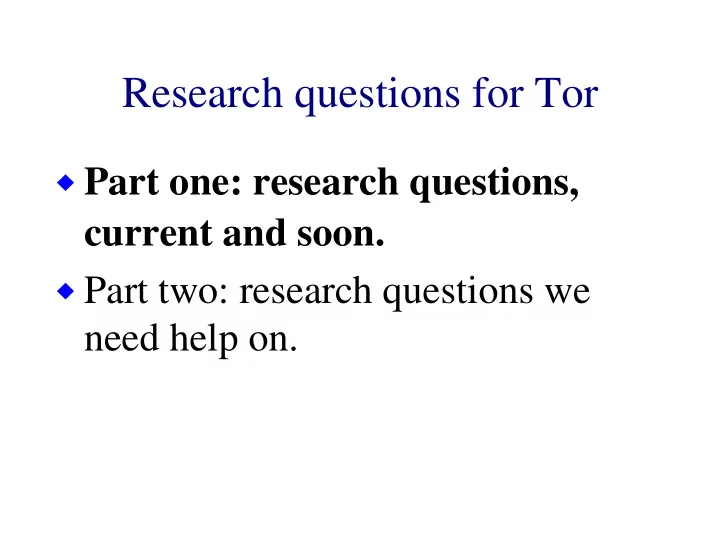

Research questions for Tor Part one: research questions, current and soon. Part two: research questions we need help on.
Decentralizing the directory Server descriptors are self-signed, so get them anywhere. Each dirserver distributes a “network status” with its belief about who's in the network, location, timestamp of their latest descriptor, etc. Threshold belief. Partitioning attacks!
Incentives to relay 1) Incentives to relay traffic 2) Incentives to do it well 3) Incentives to allow exits. Naïve tit-for-tat probably not so smart. But maybe something like it?
“Run two servers and wait” Over time, Alice will choose your nodes as entry and exit. Helper nodes. What's the right way to do helper nodes in the presence of churn?
Hidden service safety Against an adversary who runs a tor node, how long do hidden service locations stay safe? Helper nodes are one answer. Authentication/authorization is another answer.
Location diversity When many nodes are at a single ISP, and many paths are observable by a single ISP, what local algorithms can Alice use to improve (maximize?) her safety?
Tor GUI competition Two phase competition: first sketches, then implementation. Judges: Patrick Ball, Simson Garfinkel, Bruce Schneier, Adam Shostack, Edward Tufte, Ka-Ping Yee User studies from CMU?
University interest in Tor Exit nodes at Harvard, CMU, Georgia Tech, RPI, Drexel, U Texas Arlington, Rose-Hulman, Michigan Tech, U Puerto Rico, ICM (Poland), Politecnico di Milano (Italy), CTI Patras (Greece), University of Thessaloniki (Greece), ... Middleman nodes at Berkeley, MIT, MU Ohio, Virginia Tech, TU Dresden, RWTH Aachen, Cambridge University, Mirovni Institut (Slovenia), Universiteit Maastricht (NL), Uni Bremen (Germany), ... Previous nodes at Brown, Rice, UMass Amherst, U Toronto, United Nations Planetlab?
Research questions for Tor Part one: research questions, current and soon Part two: research questions we need help on.
Non-clique topology Right now we assume all nodes can reach all other nodes. We're fine as long as that's mostly true. What about Internet splits? What about nodes in China – or entire Tor networks in China? One answer is Geoff Goodell's “Blossom” project at Harvard.
Mid-latency How much latency do you need to add to start seeing end-to-end defense?
Does it mix? Does low-latency traffic provide cover (“mix”) with mid/high- latency traffic?
Website fingerprinting Do these attacks work against Tor? Does cell size change things? Does variable delay change things? What about a little bit of padding, e.g. long-range dummies?
Fragmenting streams Should we fragment streams across multiple paths?
Congestion attacks Can you “measure” Alice by ICMP pings even if she doesn't relay traffic for you? (Cf Murdoch/Danezis Oakland05 paper)
Incentives to relay Is it always unsafe to use your server for your anonymous traffic?
Pseudonyms/profiles Logging into your gmail account and then posting to Indymedia is bad. But a new circuit for every request is also bad. What's the right compromise/strategy?
Puzzles to manage load? If each server demands that Alice solves a puzzle, can we make the puzzle proportional to load? Alice's delay reveals which node she's solving a puzzle for?
Transporting UDP and IP Need IP-level packet normalization library. Application-level streams still need scrubbing (e.g. privoxy). DNS requests to your local nameserver still leak information. DTLS exists now, but we still need a new Tor protocol that handles tagging attacks, drops, resends, etc. Exit policies for arbitrary IP packets mean building a secure IDS. The Tor-internal name spaces (.onion, .exit) must be redesigned.
Government-level firewalls Step one: need a set of exit nodes on the “free” side. Step two: need a set of entry nodes on the “free” side. Step three: need a way to give out IP addresses to the good guys without letting the bad guys enumerate them. Step four: need a steg approach that makes an observer not realize you're speaking Tor.
Recommend
More recommend